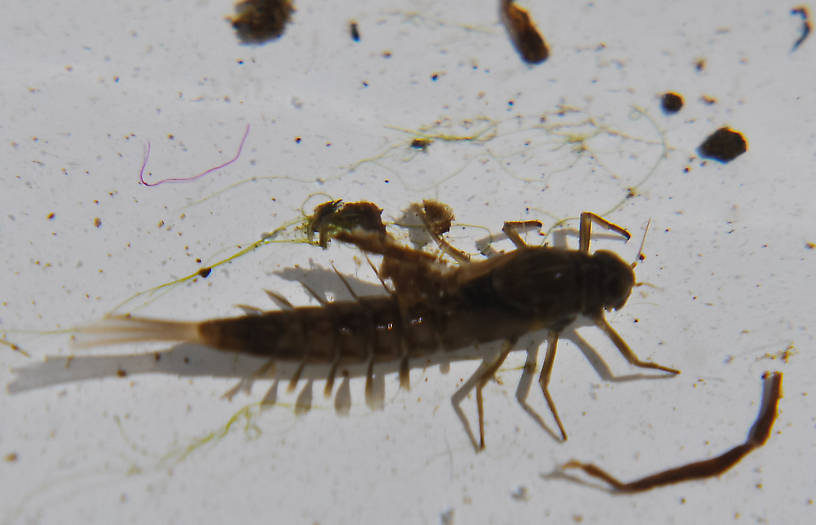
Hex Mayflies
Hexagenia limbata
The famous nocturnal Hex hatch of the Midwest (and a few other lucky locations) stirs to the surface mythically large brown trout that only touch streamers for the rest of the year.


Mayfly Species Ameletus celer (Brown Duns)
Species Range
Physical description
Most physical descriptions on Troutnut are direct or slightly edited quotes from the original scientific sources describing or updating the species, although there may be errors in copying them to this website. Such descriptions aren't always definitive, because species often turn out to be more variable than the original describers observed. In some cases, only a single specimen was described! However, they are useful starting points.
Male Spinner
Wing length: 8-14 mm
Male. Head and thorax black-brown, the postero-lateral edges of the pronotum and the membranous parts of the pleura paler brown. Abdomen dorsally with segments II-VII semihyaline, pale ochre-brown with numerous fine tracheae, posterior margins of segments dark sepia brown with narrow brown subdorsal bands projecting forward from this area, but not attaining anterior margin; posterior segments somewhat deeper in color and opaque. Ventrally somewhat paler than above, without dark bands on posterior margins, but with a median row of dark, oval, ganglionic patches; area at base of forceps paler than preceding portion. Setae whitish with slight smoky tinge, narrowly ringed with black-brown. Legs sepia-brown. Wings rather dull hyaline, due to a very faint smoky tinge; veins fine, brown, cross-veins very fine, light brown and rather faint. Genitalia with the forcep-joints rather clumsy, the penes lobes close together and subparallel, with fine spining ventrally at their bases.
Described as A. alticolus
Body length 8 mm, wing length 8 mm
A rather deep brown species, allied to Ameletus velox, A. celer, and A. celeroides (now a synonym of Ameletus celer); dark ganglionic areas present.
Head deep brown; areas laterad of antennae paler. Thorax deep brown. Posterolateral angle of pronotum tipped with creamy. Antero-lateral margin of mesonotum creamy with a tinge of pink; “a creamy patch with slight pinkish shading anterior to wing base” (McD.). Creamy brown shading on pleura. Fore legs dark brown; middle and hind legs paler, creamy brown. Wings hyaline. Longitudinal veins fine, brown; cross veins indistinct, pale; stigmatic cross veins brown, finely anastomosed. Abdominal tergites “rather even, deep, shiny brown with little deepening of color along posterior margins of segments” (McD.). Sternites pale creamy; dark mid-ventral marks on ganglionic areas. Forceps “rather short and stumpy and the excavation of the apical margin of the forceps plate is much less deep” (McD.) than in A. celer and A. celeroides; divisions of the penes short and broad with no spines basally on ventral surface (see fig. 116 from McDunnough). Distinguished from A. celeroides by the deep even brown of thorax and abdominal tergites, also in details of structure of penes.
Described as A. celeroides
Body length 8 mm, wing length 8-8.5 mm
Allied to Ameletus velox and A. celer; the abdomen is somewhat paler than in the latter; dark ganglionic patches present.
Very similar to A. celer, but much smaller. Description largely comparative. Thorax shiny blackish. Postero-lateral angle of pronotum creamy rather than brown, as in celer. Hind legs paler and duller than in celer; wings with no evidence of the smoky tinge found in that species; cross veins very fine, indistinct. Abdomen paler than in celer; the creamy shading "tends to replace the light brown shades on the abdomen, especially laterally on segments 6-8 and ventrally on segments 7 and 8; there is also a pale creamy line on the lateral edge of segment 9, this being sometimes found also on the two preceding segments” (McD.). No mention is made of ganglionic marks, hence their presence is assumed. Forceps joints “rather thin and fine and the penis-lobes are broadly divergent apically; the spining at the base ventrally seems to be limited to two small apical spines” (McD.); see fig. 116.
Female Spinner
Wing length: 13-14 mm
Nymph
The gills are smaller and much less heavily tracheated than in Ameletus velox, and there is no dark interior band of chitin, but the dorsal margin itself is chitinized and appears black-brown; the tails are pale ochreous (not blackish) and much less heavily haired than in Ameletus velox. Dorsally the abdomen is light yellow-brown to deep brown with a double row of submedian dark dashes, the included space being sometimes paler; segments VI and VII appear at times paler than the others, but the material has been too long in alcohol to be sure of any details of coloration. Ventrally the usual whitish dots are present in the antero-lateral corners of each segment and the ganglionic marks show subcutaneously. The legs are quite pale ochreous except the distal ends of the tarsi which are banded with deep brown; there is a faint smoky streak on the outer side of the femora.
Specimens of the Mayfly Species Ameletus celer
1 Nymph
Start a Discussion of Ameletus celer
References
- McDunnough, J. 1934. New species of North American Ephemeroptera IV. Canadian Entomologist 66: 154-164.
- Merritt R.W., Cummins, K.W., and Berg, M.B. 2019. An Introduction to the Aquatic Insects of North America (Fifth Edition). Kendall/Hunt Publishing Company.
Mayfly Species Ameletus celer (Brown Duns)
Species Range
Common Name
Resources
- NatureServe
- Integrated Taxonomic Information System
- Global Biodiversity Information Facility
- Described by McDunnough (1934)


